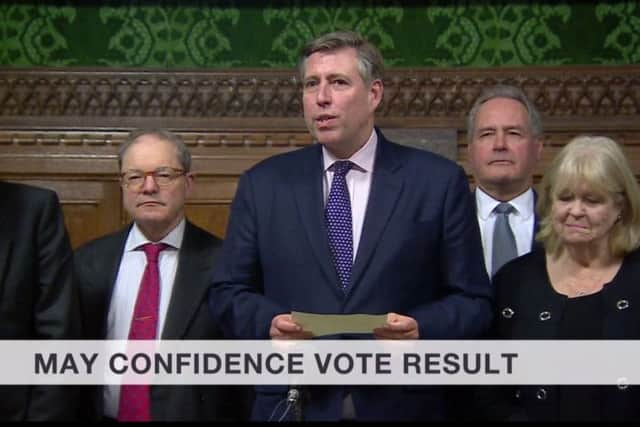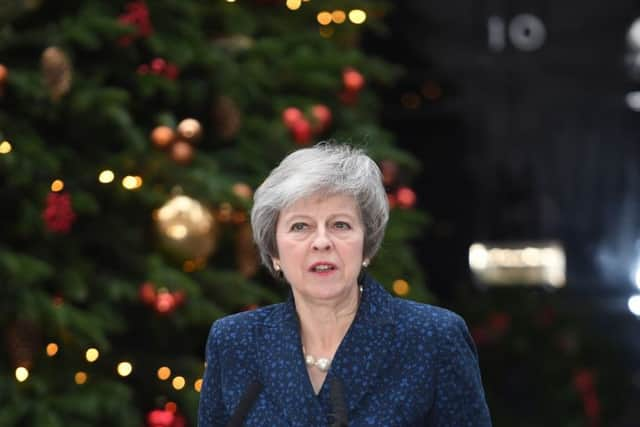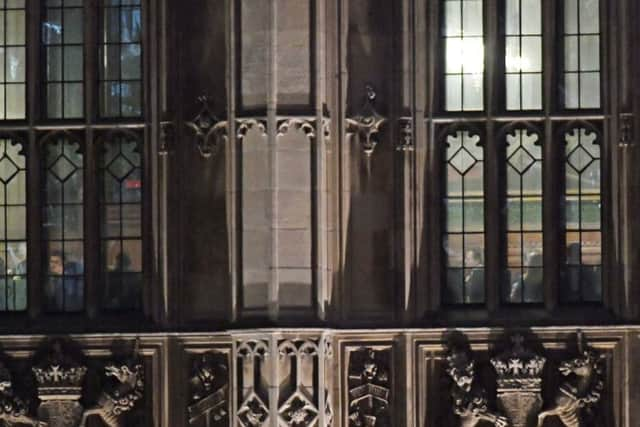Theresa May survives bid to topple her
and live on Freeview channel 276
The result, announced in the last couple of minutes, was 200 in her favour, to 117 against.
The gathering of the Conservative parliamentary party dissolved into cheering and raucous applause just after 9pm when the result was announced by Graham Brady, chairman of the Conservative body representing its Parliamentary members, the 1922 Committee.
Advertisement
Hide AdAdvertisement
Hide AdThere can be, under party rules, no similar vote on her leadership for 12 months.


She had needed 159 MPs to back her in the secret ballot.
Afterwards, Brexiteer Tory MP Jacob Rees-Mogg said the result was “terrible” for the Prime Minister, and that she should nevertheless resign.
He said that about half of all Tories in the Commons are not mere ordinary MPs, but have some connection to the government, whether it be as members of the cabinet, as trade envoys, or as parliamentary private secretaries (basically an aide to ministers).
This meant about half the people voting were effectively “in the pay of the Prime Minister in one way or another”.
Advertisement
Hide AdAdvertisement
Hide Ad

Looking at it from that point of view, it was a “terrible result” for Mrs May because it meant the “overwhelming” majority of people not on her “payroll” were likely to have opposed her.
The vote was triggered by party grandee Sir Graham Brady, the chair of the backbench 1922 Committee, early on Wednesday after he received letters of no confidence in the PM from at least 15% of the parliamentary party.
In a day of high drama, a defiant Mrs May vowed to fight “with everything I’ve got” to defend her position, warning that a change in prime minister might mean Brexit being delayed or halted.
In an early-morning statement outside 10 Downing Street, Mrs May said that securing a Brexit deal which will deliver on the result of the 2016 referendum was “now within our grasp” and said she was “making progress” in securing reassurances from EU leaders on MPs’ concerns about the proposed backstop for the Irish border.
Advertisement
Hide AdAdvertisement
Hide Ad

Every MP in her Cabinet swiftly issued statements of support and she was greeted by loud cheers from the Tory backbenches when she faced the House of Commons for her weekly session of Prime Minister’s Questions.
Addressing assembled MPs at a meeting of the 1922 Committee moments before the crucial vote, Mrs May said that she accepted she could not fight the next election as their leader.
Solicitor general Robert Buckland told reporters: “She said ‘In my heart I would like to lead the party into the next election’ and then that was the introductory phrase to her indication that she would accept the fact that that would not happen, that is not her intention.”
And, according to MPs present at the meeting, she also promised to find a “legally binding solution” to ensuring that the UK does not get permanently trapped in a backstop arrangement to keep the Irish border open after Brexit.
Advertisement
Hide AdAdvertisement
Hide AdThe scale of this task was highlighted by Irish premier Leo Varadkar and European Commission president Jean-Claude Juncker, who insisted in a phone call as MPs voted that the UK’s Withdrawal Agreement “cannot be reopened or contradicted”.
And DUP leader Arlene Foster, who met Mrs May shortly before the ballot, insisted that “tinkering around the edges” of the agreement would not be enough to win her party’s support for the deal.
Mrs Foster, whose 10 MPs prop up the minority Conservative administration, said she told the PM that “we were not seeking assurances or promises, we wanted fundamental legal text changes”.
Anger over the backstop among Tory backbenchers and their Democratic Unionist Party allies was the main obstacle to Mrs May getting her Brexit deal through the House of Commons earlier this week.
Advertisement
Hide AdAdvertisement
Hide AdHer decision to defer the vote sparked a new wave of letters of no confidence which pushed the total beyond the threshold of 48 needed to trigger a ballot.
By the time of the vote, Mrs May’s survival looked assured, with the tally of Tory MPs publicly declaring they would support her passing the threshold of 159 needed to secure her position.
Mrs May’s victory in the confidence vote means that another challenge cannot be mounted against her position as Tory leader for a year.
But she still faces the danger of a no-confidence motion in the House of Commons, which could bring her Government down if backed by more than half of all MPs.
And Labour MPs branded her a “lame duck” PM because of her decision to pre-announce her departure.